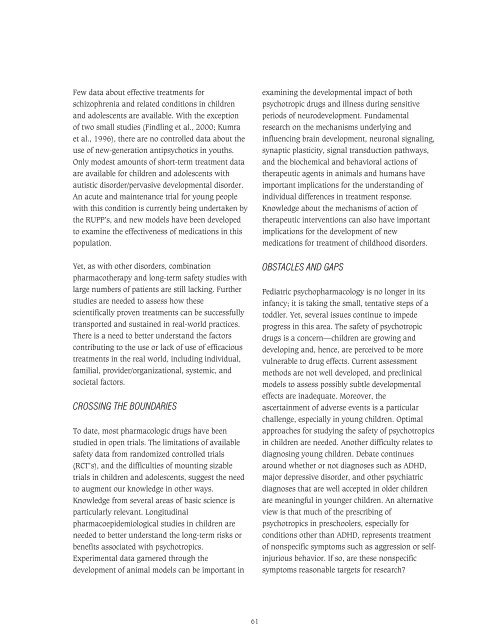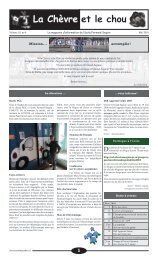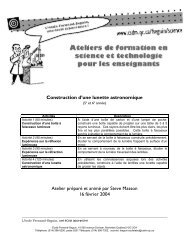Research on Child and Adolescent Mental Health
Research on Child and Adolescent Mental Health
Research on Child and Adolescent Mental Health
Create successful ePaper yourself
Turn your PDF publications into a flip-book with our unique Google optimized e-Paper software.
Few data about effective treatments for<br />
schizophrenia <strong>and</strong> related c<strong>on</strong>diti<strong>on</strong>s in children<br />
<strong>and</strong> adolescents are available. With the excepti<strong>on</strong><br />
of two small studies (Findling et al., 2000; Kumra<br />
et al., 1996), there are no c<strong>on</strong>trolled data about the<br />
use of new-generati<strong>on</strong> antipsychotics in youths.<br />
Only modest amounts of short-term treatment data<br />
are available for children <strong>and</strong> adolescents with<br />
autistic disorder/pervasive developmental disorder.<br />
An acute <strong>and</strong> maintenance trial for young people<br />
with this c<strong>on</strong>diti<strong>on</strong> is currently being undertaken by<br />
the RUPP’s, <strong>and</strong> new models have been developed<br />
to examine the effectiveness of medicati<strong>on</strong>s in this<br />
populati<strong>on</strong>.<br />
Yet, as with other disorders, combinati<strong>on</strong><br />
pharmacotherapy <strong>and</strong> l<strong>on</strong>g-term safety studies with<br />
large numbers of patients are still lacking. Further<br />
studies are needed to assess how these<br />
scientifically proven treatments can be successfully<br />
transported <strong>and</strong> sustained in real-world practices.<br />
There is a need to better underst<strong>and</strong> the factors<br />
c<strong>on</strong>tributing to the use or lack of use of efficacious<br />
treatments in the real world, including individual,<br />
familial, provider/organizati<strong>on</strong>al, systemic, <strong>and</strong><br />
societal factors.<br />
CROSSING THE BOUNDARIES<br />
To date, most pharmacologic drugs have been<br />
studied in open trials. The limitati<strong>on</strong>s of available<br />
safety data from r<strong>and</strong>omized c<strong>on</strong>trolled trials<br />
(RCT’s), <strong>and</strong> the difficulties of mounting sizable<br />
trials in children <strong>and</strong> adolescents, suggest the need<br />
to augment our knowledge in other ways.<br />
Knowledge from several areas of basic science is<br />
particularly relevant. L<strong>on</strong>gitudinal<br />
pharmacoepidemiological studies in children are<br />
needed to better underst<strong>and</strong> the l<strong>on</strong>g-term risks or<br />
benefits associated with psychotropics.<br />
Experimental data garnered through the<br />
development of animal models can be important in<br />
examining the developmental impact of both<br />
psychotropic drugs <strong>and</strong> illness during sensitive<br />
periods of neurodevelopment. Fundamental<br />
research <strong>on</strong> the mechanisms underlying <strong>and</strong><br />
influencing brain development, neur<strong>on</strong>al signaling,<br />
synaptic plasticity, signal transducti<strong>on</strong> pathways,<br />
<strong>and</strong> the biochemical <strong>and</strong> behavioral acti<strong>on</strong>s of<br />
therapeutic agents in animals <strong>and</strong> humans have<br />
important implicati<strong>on</strong>s for the underst<strong>and</strong>ing of<br />
individual differences in treatment resp<strong>on</strong>se.<br />
Knowledge about the mechanisms of acti<strong>on</strong> of<br />
therapeutic interventi<strong>on</strong>s can also have important<br />
implicati<strong>on</strong>s for the development of new<br />
medicati<strong>on</strong>s for treatment of childhood disorders.<br />
OBSTACLES AND GAPS<br />
Pediatric psychopharmacology is no l<strong>on</strong>ger in its<br />
infancy; it is taking the small, tentative steps of a<br />
toddler. Yet, several issues c<strong>on</strong>tinue to impede<br />
progress in this area. The safety of psychotropic<br />
drugs is a c<strong>on</strong>cern—children are growing <strong>and</strong><br />
developing <strong>and</strong>, hence, are perceived to be more<br />
vulnerable to drug effects. Current assessment<br />
methods are not well developed, <strong>and</strong> preclinical<br />
models to assess possibly subtle developmental<br />
effects are inadequate. Moreover, the<br />
ascertainment of adverse events is a particular<br />
challenge, especially in young children. Optimal<br />
approaches for studying the safety of psychotropics<br />
in children are needed. Another difficulty relates to<br />
diagnosing young children. Debate c<strong>on</strong>tinues<br />
around whether or not diagnoses such as ADHD,<br />
major depressive disorder, <strong>and</strong> other psychiatric<br />
diagnoses that are well accepted in older children<br />
are meaningful in younger children. An alternative<br />
view is that much of the prescribing of<br />
psychotropics in preschoolers, especially for<br />
c<strong>on</strong>diti<strong>on</strong>s other than ADHD, represents treatment<br />
of n<strong>on</strong>specific symptoms such as aggressi<strong>on</strong> or selfinjurious<br />
behavior. If so, are these n<strong>on</strong>specific<br />
symptoms reas<strong>on</strong>able targets for research<br />
61

















